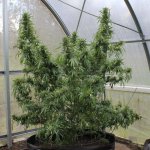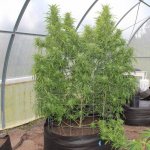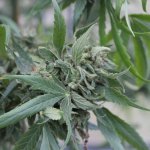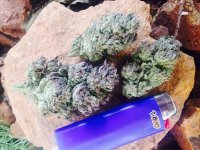You are using an out of date browser. It may not display this or other websites correctly.
You should upgrade or use an alternative browser.
You should upgrade or use an alternative browser.
- Status
- Not open for further replies.
These are as large as my patio will allow. If I was under blue sky they would be massively larger, but who cares. It's the thought that counts......or lack thereof hahaha.




These girls are running in 30 gallon Roottrapper smartpots with a soil mix of Fox Farm Happy Frog, sphagnum moss, Agricola's 4-8-4 organic super fertilizer, local pure worm castings, and some spirulina mixed in for good measure.




These girls are running in 30 gallon Roottrapper smartpots with a soil mix of Fox Farm Happy Frog, sphagnum moss, Agricola's 4-8-4 organic super fertilizer, local pure worm castings, and some spirulina mixed in for good measure.
links fixed....
Thumbs up Walipini Construction ( UNDERGROUND green house )
$300 Underground Greenhouse Grows Produce Year-Round, Even in Severe Climates
With staggering food prices and shortages looming, there’s no better time to grow your own produce. Sadly, most greenhouses are expensive to build and impractical to heat during cold, wintery conditions. Thankfully, a solution is found with the Walipini. Developed for South American mountainous regions over twenty years ago, it allows edibles to be grown year-round – even in the most inhospitable weather. As an added bonus, it’s also outrageously inexpensive to construct.
Known as a pit or underground greenhouse, the Walipini utilizes the advantages of passive solar heating along with earth sheltering properties. The structure makes use of thermal mass energy, creating a highly efficient and cost effective method for heating the interior. Regardless of where you live, produce can be grown year round with the Walipini. According to the creators at the Benson Institute:
“The Walipini, in simplest terms, is a rectangular hole in the ground 6′ to 8′ deep covered by plastic sheeting. The longest area of the rectangle faces the winter sun — to the north in the Southern Hemisphere and to the south in the Northern Hemisphere. A thick wall of rammed earth at the back of the building and a much lower wall at the front provide the needed angle for the plastic sheet roof. This roof seals the hole, provides an insulating airspace between the two layers of plastic (a sheet on the top and another on the bottom of the roof/poles) and allows the suns rays to penetrate creating a warm, stable environment for plant growth.”
The Institute continues with an explanation of how the earth acts like a battery, storing heat during the day while releasing it during cooler nighttime temperatures:
Energy and light from the sun enter the Walipini through the plastic covered roof and are reflected and absorbed throughout the underground structure. By using translucent material, plastic instead of glass, plant growth is improved as certain rays of the light spectrum that inhibit plant growth are filtered out. The sun’s rays provide both heat and light needed by plants. Heat is not only immediately provided as the light enters and heats the air, but heat is also stored as the mass of the entire building absorbs heat from the sun’s rays.
The estimated building cost (using volunteer labor) for a 20 x 74 foot Walipini in La Paz, Peru is between $250 – $300. Taking advantage of inexpensive materials like PVC pipes and ultraviolet (UV) protective plastic sheeting add to the savings.
A detailed do-it-yourself building manual can be found here and includes crucial instructions for ventilation, waterproofing and drainage.
http://www.walipinigarden.com/
http://www.treehugger.com/green-arch...get&id=1515577
this changed my entire way of thinking / planning next year.....
Thumbs up Walipini Construction ( UNDERGROUND green house )
$300 Underground Greenhouse Grows Produce Year-Round, Even in Severe Climates
With staggering food prices and shortages looming, there’s no better time to grow your own produce. Sadly, most greenhouses are expensive to build and impractical to heat during cold, wintery conditions. Thankfully, a solution is found with the Walipini. Developed for South American mountainous regions over twenty years ago, it allows edibles to be grown year-round – even in the most inhospitable weather. As an added bonus, it’s also outrageously inexpensive to construct.
Known as a pit or underground greenhouse, the Walipini utilizes the advantages of passive solar heating along with earth sheltering properties. The structure makes use of thermal mass energy, creating a highly efficient and cost effective method for heating the interior. Regardless of where you live, produce can be grown year round with the Walipini. According to the creators at the Benson Institute:
“The Walipini, in simplest terms, is a rectangular hole in the ground 6′ to 8′ deep covered by plastic sheeting. The longest area of the rectangle faces the winter sun — to the north in the Southern Hemisphere and to the south in the Northern Hemisphere. A thick wall of rammed earth at the back of the building and a much lower wall at the front provide the needed angle for the plastic sheet roof. This roof seals the hole, provides an insulating airspace between the two layers of plastic (a sheet on the top and another on the bottom of the roof/poles) and allows the suns rays to penetrate creating a warm, stable environment for plant growth.”
The Institute continues with an explanation of how the earth acts like a battery, storing heat during the day while releasing it during cooler nighttime temperatures:
Energy and light from the sun enter the Walipini through the plastic covered roof and are reflected and absorbed throughout the underground structure. By using translucent material, plastic instead of glass, plant growth is improved as certain rays of the light spectrum that inhibit plant growth are filtered out. The sun’s rays provide both heat and light needed by plants. Heat is not only immediately provided as the light enters and heats the air, but heat is also stored as the mass of the entire building absorbs heat from the sun’s rays.
The estimated building cost (using volunteer labor) for a 20 x 74 foot Walipini in La Paz, Peru is between $250 – $300. Taking advantage of inexpensive materials like PVC pipes and ultraviolet (UV) protective plastic sheeting add to the savings.
A detailed do-it-yourself building manual can be found here and includes crucial instructions for ventilation, waterproofing and drainage.
http://www.walipinigarden.com/
http://www.treehugger.com/green-arch...get&id=1515577
this changed my entire way of thinking / planning next year.....
Are those from your old time genetics Madjag ?
Madjag, I'm loving the little I can see of that patio, how many hours of direct sun-light do they get? the plants are looking very nice as well.
peace!
peace!
C
Cep
Here is the other thing I find meself curious about. If I go with a real high organic mix in a 200 gallon pot can I , in fact, get enough minerals to carry me through the grow. Then maybe all I got to do is fertigate N Throughtout the grow. AS early on and maybe an amino late.
I find meself wondering about a lot of things
I did this with one smaller bed this year and I think the initial pH was 6.8-6.9, intentionally a little oversaturated because there wasn't a lot of soil volume. pH still dropped to 5.7 and I actualy got K deficiencies showing unlike the rest of my plot. The plants did really well and I only had to give them a few shots of ppd foliars and low doses of CaNO3.
Edit: If I had a ton of soil, like 5+ yards, I would just amend like usual and prob see the same results. Always looking to decrease work load with foliars, drenches, etc.
mendo-local
Member
Ok I cleaned this up ... Well pretty much just threw out the last cpl pages. If your post has been deleted and you didnt really feel it had anything negative to say in it ... just know that I did a mass deletion of anything to do with the off topic banter and just tried to get this back on track. Please lets not take it all so personal and lets not make snide or snarky remarks at each other .
We are all in this together and here to help each other ... lets try to make the vibe here right . We are a site to exchange knowledge ... lets try to continue doing that without all the personal rifts and in fighting . Lets try to get a good vibe going here with each other and then keep it that way. Lets treat each other with the highest respect we can give !!
Now who's got some pics of some large plants ?
Thank you. I used to love you're outdoor thread and pics. Do you have anything new to share? Peace
mendo-local
Member
I have a question for you guys. I've always ran seeds outside but this year I had a good feeling about my plants and I took clones off of a few of my favorites. They ended up being absolutely amazing, so I'm wondering if I run these next year will I have the same finish date? I mean planting early sub. Light but a full term big plant.
Plants don't like the heat. Aloha DB This is from this morning.
http://hvo.wr.usgs.gov/multimedia/uploads/600x450/previewImage-922.jpg
http://hvo.wr.usgs.gov/multimedia/uploads/600x450/previewImage-922.jpg
Are those from your old time genetics Madjag ?
Oh I wish......unfortunately back in the late 70's when I bought 3000 seeds of Skunk #1 from Sam through my friend Rob Clarke, I was too young to understand the true value of what I was holding and planting. We were so into it that we didn't miss a single male and had no known seeds. Alas, hindsight.
These girls in the current photos represent Magus Genetics' Warlock crosses, a Masibindi male, Zaml A x Warlock, crossed with either a MNS Critical Mass F2 girl or with another Magus strain, Warlock x (Warlock x Zamal B). The massive cola plant is one of the Critical Mass phenos that defintiely shows the "Big Bud" that Shantibaba reworked to create CM. Plenty of Skunk #1 in that one.

Your table is ready....
@bombadil.360
The clear Lexan panels I use are 92% transmissive. I had tinted Lexan a few years ago and discovered that they only had 30% transmissivity. Fvck me. I replaced half of them, the half of the patio I use for growing.
Because of the walls surrounding my patio and keeping it private even with the neighbor's driveway 12 feet away, my girls get only the sun passing directly over and a bit at lower angle in the afternoon. Somewhere between 6-9 hours depending on the month. I start them in the back yard in 3 gallon smartpots and once they reach 24" or so, I put them into their final 30 gallon smarties and bring them into the patio.
Oh I wish......unfortunately back in the late 70's when I bought 3000 seeds of Skunk #1 from Sam through my friend Rob Clarke, I was too young to understand the true value of what I was holding and planting.
Right on man. I really appreciated your Madjag canyon stories and think you should write a book...I'd definitely read a copy. There's a few from what life was like around here back then..one of them is called Cash Crop..check it out if you can find a copy.
I think every grower has a hindsight story. Mine is not even flowering some Emerald Triangle Funk x Purple seeds I got through Subcool...Yep..The seeds that brought on the Dankassbitch...My bad!
cannascholar
Member
I did this with one smaller bed this year and I think the initial pH was 6.8-6.9, intentionally a little oversaturated because there wasn't a lot of soil volume. pH still dropped to 5.7 and I actualy got K deficiencies showing unlike the rest of my plot. The plants did really well and I only had to give them a few shots of ppd foliars and low doses of CaNO3.
Edit: If I had a ton of soil, like 5+ yards, I would just amend like usual and prob see the same results. Always looking to decrease work load with foliars, drenches, etc.
Great info bro. You might could push it to 7 at first anf foliar k after august. Maybe feed N all the way. Probably better to pick 400 gallons as a start...put out small plants 6/1 and run bigger numbers.
Definitely don't want to be above 6.5 when august stretch starts. Micris and ultra traces determine quality if you ask me...and that don't happen above 7.
mendo-local
Member
^^frosty and chunking! Just the way I like em...
C
Cep
Blue bubba from hazeman is my favorite from this year. Yields good for a bubba cross. This was done open sun in vermifire.
His seeds are cheap and very high quality. How did that one smoke?
Great info bro. You might could push it to 7 at first anf foliar k after august. Maybe feed N all the way. Probably better to pick 400 gallons as a start...put out small plants 6/1 and run bigger numbers.
Definitely don't want to be above 6.5 when august stretch starts. Micris and ultra traces determine quality if you ask me...and that don't happen above 7.
I don't think I've ever had soil above 6.2 around that time. Just keeps getting more acidic the deeper you go. I really don't mind too much if there is a slight K defiency. Those plants always seem to be the last to mold. Plus there are so many specialized additives that contain K that I dont have to worry about in that case.
Cep...I was talking with GR about sap analysis. Rule of thumb is 1:1 K:Ca for most plants. But all over the map. Hops is 2:1...somehow I bet mj is in that category. How else can you explain the success of the coot mix?
Damn it would be nice to find out
2:1 in favor of K? I was hoping
 to hear back from someone (either Redding or Smith) about the hop numbers.
to hear back from someone (either Redding or Smith) about the hop numbers.Yea K. But who knows if that translates.
Based on the soil tests I see pH is maybe a better indication of how full the battery really is provided you don't have way too much nitrate in there mucking things up. High organic matter and a balaced starter fertilizer makes sense
What did late tissue tests shoe re: K:Ca? Should be lots of Ca in the tissue.
Based on the soil tests I see pH is maybe a better indication of how full the battery really is provided you don't have way too much nitrate in there mucking things up. High organic matter and a balaced starter fertilizer makes sense
What did late tissue tests shoe re: K:Ca? Should be lots of Ca in the tissue.
MelloYello
Active member
I have a question for you guys. I've always ran seeds outside but this year I had a good feeling about my plants and I took clones off of a few of my favorites. They ended up being absolutely amazing, so I'm wondering if I run these next year will I have the same finish date? I mean planting early sub. Light but a full term big plant.
Should finish earlier.
- Status
- Not open for further replies.






